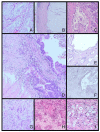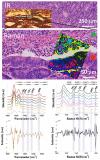Current Pathology Model of Pancreatic Cancer
- PMID: 35565450
- PMCID: PMC9105915
- DOI: 10.3390/cancers14092321
Current Pathology Model of Pancreatic Cancer
Abstract
Pancreatic cancer (PC) is one of the most aggressive and lethal malignant neoplasms, ranking in seventh place in the world in terms of the incidence of death, with overall 5-year survival rates still below 10%. The knowledge about PC pathomechanisms is rapidly expanding. Daily reports reveal new aspects of tumor biology, including its molecular and morphological heterogeneity, explain complicated "cross-talk" that happens between the cancer cells and tumor stroma, or the nature of the PC-associated neural remodeling (PANR). Staying up-to-date is hard and crucial at the same time. In this review, we are focusing on a comprehensive summary of PC aspects that are important in pathologic reporting, impact patients' outcomes, and bring meaningful information for clinicians. Finally, we show promising new trends in diagnostic technologies that might bring a difference in PC early diagnosis.
Keywords: morphological subtyping; pancreatic adenocarcinoma; pancreatic cancer heterogeneity; pancreatic cancer spectroscopy; pancreatic neural remodeling; pathology reporting.
Conflict of interest statement
The authors declare no conflict of interest.
Figures





Similar articles
-
Vibrational spectroscopy - are we close to finding a solution for early pancreatic cancer diagnosis?World J Gastroenterol. 2023 Jan 7;29(1):96-109. doi: 10.3748/wjg.v29.i1.96. World J Gastroenterol. 2023. PMID: 36683712 Free PMC article. Review.
-
Pancreatic Cancer Related Pain: Review of Pathophysiology and Intrathecal Drug Delivery Systems for Pain Management.Pain Physician. 2021 Aug;24(5):E583-E594. Pain Physician. 2021. PMID: 34323445 Review.
-
Characterization of anoikis-based molecular heterogeneity in pancreatic cancer and pancreatic neuroendocrine tumor and its association with tumor immune microenvironment and metabolic remodeling.Front Endocrinol (Lausanne). 2023 May 10;14:1153909. doi: 10.3389/fendo.2023.1153909. eCollection 2023. Front Endocrinol (Lausanne). 2023. PMID: 37234801 Free PMC article.
-
Variabilities in global DNA methylation and β-sheet richness establish spectroscopic landscapes among subtypes of pancreatic cancer.Eur J Nucl Med Mol Imaging. 2023 May;50(6):1792-1810. doi: 10.1007/s00259-023-06121-7. Epub 2023 Feb 9. Eur J Nucl Med Mol Imaging. 2023. PMID: 36757432 Free PMC article.
-
Crosstalk between miRNAs and signaling pathways involved in pancreatic cancer and pancreatic ductal adenocarcinoma.Eur J Pharmacol. 2021 Jun 15;901:174006. doi: 10.1016/j.ejphar.2021.174006. Epub 2021 Mar 9. Eur J Pharmacol. 2021. PMID: 33711308 Review.
Cited by
-
3D Bioprinting as a Powerful Technique for Recreating the Tumor Microenvironment.Gels. 2023 Jun 12;9(6):482. doi: 10.3390/gels9060482. Gels. 2023. PMID: 37367152 Free PMC article. Review.
-
Vibrational spectroscopy - are we close to finding a solution for early pancreatic cancer diagnosis?World J Gastroenterol. 2023 Jan 7;29(1):96-109. doi: 10.3748/wjg.v29.i1.96. World J Gastroenterol. 2023. PMID: 36683712 Free PMC article. Review.
-
Combined analytical approach empowers precise spectroscopic interpretation of subcellular components of pancreatic cancer cells.Anal Bioanal Chem. 2023 Dec;415(29-30):7281-7295. doi: 10.1007/s00216-023-04997-w. Epub 2023 Oct 31. Anal Bioanal Chem. 2023. PMID: 37906289 Free PMC article.
-
Information maximization-based clustering of histopathology images using deep learning.PLOS Digit Health. 2023 Dec 8;2(12):e0000391. doi: 10.1371/journal.pdig.0000391. eCollection 2023 Dec. PLOS Digit Health. 2023. PMID: 38064416 Free PMC article.
-
Spatial recognition and semi-quantification of epigenetic events in pancreatic cancer subtypes with multiplexed molecular imaging and machine learning.Sci Rep. 2025 Feb 22;15(1):6518. doi: 10.1038/s41598-025-90087-z. Sci Rep. 2025. PMID: 39987295 Free PMC article.
References
Publication types
Grants and funding
LinkOut - more resources
Full Text Sources

